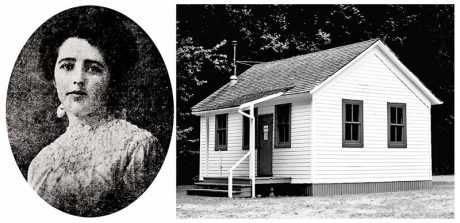Louise Bryant: Stuart Island to Bolshevik Revolution
Posted September 4, 2019 at 5:49 am by Tim Dustrude
It’s that time once again for this month’s history column from the San Juan Historical Society and Museum…
It’s not often that a tiny slice of local history becomes part of an international story of considerable fame, but this is one of them. The Stuart Island portion begins on March 27, 1909 when the mail boat from Bellingham arrives on the island, bringing with it a new school teacher.
This is 23-year-old Louise Bryant (pictured above in 1904). It is the same Louise Bryant who would go on to become an internationally known foreign war correspondent, marry activist John Reed (then after him, William C. Bullitt, the first U.S. Ambassador to the Soviet Union), and be played by Diane Keaton in the 1981 Academy Award winning film Reds.
But back to Stuart Island…
On that spring day in 1909, many family members of the 20 or so children of Stuart Island School are gathered at the mail dock, waiting to greet “Miss Louise,” coming from Portland, Oregon, after graduating from the University of Oregon with a degree in history. Louise’s salary of $50 a month will have room and board taken out to compensate her host family. This is the family of the Turn Point lighthouse keeper, Louis Borchers, Sr., and it is his daughter Leila we can thank for a first-hand account of Louise’s time on the island.
Although only seven years old at the time, Leila would have much to share decades later when she was interviewed in her 70s by a writer researching the story beyond the headlines of Louise Bryant. In Leila’s words, “Nobody on the island had ever seen anyone dressed so beautifully as she was, except maybe in mail order catalogs.” Leila also remembered the pleasant scent of Louise’s perfume, about which her mother Callie Borchers said, “Good girls and ladies don’t wear perfume.”
Archived issues of the San Juan Islander newspaper also add glimpses into those days on Stuart Island. From the April 2, 1909 issue, in the news from Stuart Island column:
“Miss Louise Bryant arrived Saturday to open school Monday, March 29 in district No. 26. Miss Bryant will teach a five months’ term.”
Opening up school in the spring after a long winter closure was a tradition to avoid storms and high seas, since some students had to row over from Spieden Island. Classmates in the one room schoolhouse (built in 1904, pictured here) included children from the Borchers, Chevalier, Cepas, Droullard, and Mordhorst families, in addition to others. As for a social life on the weekends, Louise helped clean fish caught by the island’s three unmarried Finns (borrowing appropriate attire from them) or joined the Borchers family for outings to Pender Island and Roche Harbor.
In mid-April the mail boat brought a letter for Louise, with an invitation to return to the University of Oregon in Eugene for a ceremony and festivities surrounding the national chartering of the sorority she helped establish, where she served as first president. Even though Louise had been on Stuart for just a few weeks, Mrs. Borchers agreed to teach in her place “for a week or so” and off she went back to Oregon.
On April 18, the Eugene newspaper reported that Louise had arrived on the train, saying “She is very popular here and many social affairs are being planned in her honor.” A few days later, Louise wrote to the Borchers, asking them to send her trunk of belongings because she had accepted a job writing for a Portland newspaper and would not be returning to Stuart Island.
On May 7, the San Juan Islander newspaper reported that
“L.A. Borchers and two sons Louis and Lawrence made a trip to Mitchell Bay to get Miss Bertha Baats, who will finish the term of school in district No. 26.”
Later that year, the Borchers received a Christmas card from Louise. It ended with “Love to everybody. Tell my Finns I love them.” It was signed “Louise Bryant Trullinger,” as Louise had recently married the first of her three husbands.
Our story could end there, but the rest of Louise’s life deserves the inclusion of a few highlights to position her in the larger picture of our country’s history and Stuart Island’s connection to it.
Louise’s career as a Portland journalist worked well with her growing passion as a community activist. Early assignments to cover social events faded away to focus on the politics and movements of the time. Louise actively campaigned for the women’s right to vote, leading up to Oregon’s passage of the Equal Suffrage Proclamation in 1912. Within the next few years, she met radical journalist John Reed (a founder of the Communist Labor Party and author of “Ten Days That Shook the World”), divorced her husband, and moved with Reed to New York. By 1917, they were married and in Russia witnessing the Bolshevik Revolution. Louise’s series of 32 articles, based upon her experiences and interviews with Lenin, Trotsky, Kerensky, and others, was syndicated by Hearst and would appear in over 100 U.S. newspapers. Her book “Six Red Months in Russia” was translated into five languages almost as soon as it was published in 1918.
Louise was a daring and influential foreign correspondent. Upon her return to the U.S., a national speaking tour took her to sold out halls across the nation. One event in Portland attracted 4,000 people in 1919. She spoke not only on her overseas experiences, but also on domestic causes that she supported. During an assignment to cover the women’s suffrage movement, she and other suffragists were jailed for three days in Washington, D.C. after being arrested during a National Woman’s Party rally in front of the White House.
After returning home to the U.S. for a short time, John Reed traveled back to Russia where he became gravely ill with typhus. Louise was with him in 1920 when he died in Moscow. She walked behind his casket during his state funeral procession in Red Square and fainted along the route. Reed is the most well-known of the few Americans buried at the Kremlin Wall.
In 1923 Louise married American diplomat William C. Bullitt in Rome. Their daughter Anne was born the next year in Paris and raised by Bullitt after his 1930 divorce from Louise. Louise continued to work as a foreign correspondent in several European countries, although the early onset of a rare and debilitating disease curtailed her activity. Louise Bryant died in Paris from a cerebral hemorrhage at age 50.
John Reed once wrote of Louise that she was “wild and brave” and “a lover of all adventure of spirit and of mind.” Others noted her “brilliant wit” and called her “intellectually alive.” To read more about Louise Bryant, we can recommend what the Oregon Historical Society has published about her. If you know anything about her time on Stuart Island, please let the San Juan Historical Society and Museum know.
You can support the San Juan Update by doing business with our loyal advertisers, and by making a one-time contribution or a recurring donation.
Categories: History, People
One comment:











One comment...
Very interesting story! Also useful information about the Stuart Island school, and families involved. Tom (Orcas Id)
By submitting a comment you grant the San Juan Update a perpetual license to reproduce your words and name/web site in attribution. Inappropriate, irrelevant and contentious comments may not be published at an admin's discretion. Your email is used for verification purposes only, it will never be shared.